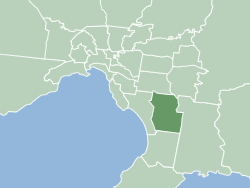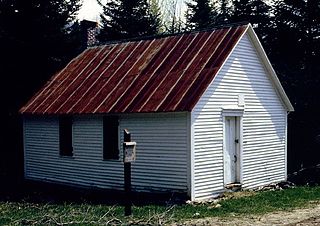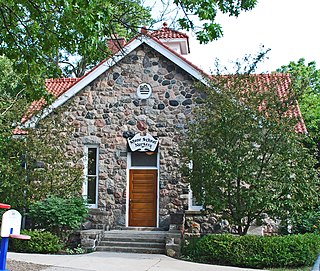
Elk River is a city in Sherburne County, Minnesota, United States, approximately 34 miles northwest of Minneapolis. Known as the Energy City since 1997. It is situated at the confluence of the Mississippi and Elk Rivers. The population was 25,835 at the 2020 census, making Elk River the second largest city with an area of 42.33 square miles in the Central Minnesota region after St. Cloud. It is the county seat. U.S. Highways 10 and 169 and State Highway 101 are three of the main routes in Elk River, and a station on the Northstar Commuter Rail line to downtown Minneapolis is located in the city. Elk River is located 33.2 miles northwest of Minneapolis and 37.4 miles southeast of St. Cloud.

The City of Greater Dandenong is a local government area in Victoria, Australia in the southeastern suburbs of Melbourne. It has an area of just under 130 square kilometres and 166,094 residents in 2018. 29% of its land area forms part of the South East Green Wedge. It was formed in 1994 by the merger of parts of the former City of Dandenong and City of Springvale.

Memorial Stadium is a double-decked concrete and steel stadium in northeast Bakersfield, California, near the scenic Panorama Bluffs which overlook the prolific Kern River Oilfields. In July 2019 an artificial playing surface was installed replacing the worn out and troublesome Bermuda grass field which was susceptible to fungus growth. An all-weather track was also installed In 2020 a new scoreboard and sound system were installed along with new L.E.D. lights placed upon the original light standards.

The Elks Club Building is a historic site in Jacksonville, Florida. It is located at 201-213 North Laura Street. As its name implies, it was once a headquarters for the local chapter of The Elks. On March 9, 2000, it was added to the U.S. National Register of Historic Places, because of the historic influence of Elks establishments in the United States communities.

The U.S. Post Office in Beacon, New York, is located on Main Street. It serves the ZIP Code 12508, covering the entire city of Beacon and some of the neighboring areas of the Town of Fishkill. It is a stone structure in the Dutch Colonial Revival architectural style built in the mid-1930s. In 1988 it was listed on the National Register of Historic Places along with many other older post offices in the state.

The Deerwood Auditorium is a community center in Deerwood, Minnesota, United States. It was built as a New Deal project from 1935 to 1937. In 1995 the auditorium was listed on the National Register of Historic Places for its local significance in the themes of architecture, politics/government, and social history. It was nominated for being an exemplary multipurpose municipal building funded by the New Deal, as well as Minnesota's largest project by the State Emergency Relief Administration, and a longstanding venue for community events.

George Washington Memorial Park is located at the center of Jackson, Wyoming. More generally known as "Town Square", the park is notable for its elk-antler arches at each corner of the park, collected from the nearby National Elk Refuge by Boy Scouts and periodically rebuilt. The square originally existed as an open space in the center of town that was made into a park in 1934. The park center also contains a stone memorial to John Colter.
Hockey Day Minnesota is an annual event in Minnesota run in cooperation with the Minnesota Wild and Bally Sports North that celebrates the sport of hockey throughout the state. Now a multi-day showcase, the event is held in mid-to-late January or early February and typically consists of multiple high school games, a men's and/or women's college hockey game, and concludes with a Minnesota Wild NHL game. With some games now taking place on Thursday and Friday, the main set of games are played on a Saturday and are broadcast on FSN. Most of the games are played at a featured outdoor location with a rink built specifically for the event. However, some of the college matchups are played in standard home arenas and all of the Wild games are played in an NHL venue.

The US 41–Fanny Hooe Creek Bridge is a highway bridge located on US Highway 41 (US 41) over the Fanny Hooe Creek about one mile east of Copper Harbor, adjacent to Fort Wilkins State Park, in Grant Township, Michigan. It was listed on the National Register of Historic Places in 1999.

The Willimantic Elks Club is a historic Elks lodge at 198 Pleasant Street in the Willimantic section of Windham, Connecticut. Built in 1925 for a lodge founded in 1914, it is one of the finest examples of Tudor Revival architecture in the region, and has been a major site of social events in the community since. The building was added to the National Register of Historic Places in 2005.

The former District 10 School is located just north of state highways 28 and 30 south of Margaretville, New York, United States. It is a stone one-room schoolhouse built, demolished and rebuilt in the middle of the 19th century.

The Elk Rapids Township Hall is a former government building located on River Street in Elk Rapids, Michigan. It was designated a Michigan State Historic Site in 1973 and listed on the National Register of Historic Places in 1977. The building was refurbished, and as of 2020, the building served as a rental space and performance venue known as HERTH Hall.

The District No. 1 Schoolhouse is a historic one-room schoolhouse on Somerset Road in Somerset, Vermont, United States. Built about 1850, it is the only known entirely unaltered district schoolhouse in the state, and is probably the only surviving municipal building from the tiny community, which was disincorporated in 1937. The building was listed on the National Register of Historic Places in 1992.
Valhalla Highlands Historic District, also known as Lake Valhalla, is a national historic district located near Cold Spring in Putnam County, New York. The district encompasses 57 contributing buildings, 11 contributing sites, 10 contributing structures, 7 contributing objects and a 900-acre forest in an early second home community established by primarily German/Austrians and Norwegians from New York City. It developed between the early-1930s and mid-1940s, and includes lodges that are typically one or two stories high and have fieldstone foundations. They are characterized by structural stone walls and full log construction and frame dwellings clad with half-log wood siding and fieldstone veneer, chimneys and terraces. The district also includes a boat lodge with a ping-pong room and terrace, a swimming dock, a boat dock, a tea pavilion, a recreation pavilion, a lookout pavilion, shuffleboard courts, a tennis court, a playing field, a picnic area, rustic improvements throughout the forest and the remnants of a hunting cabin.

The Grist Mill Bridge, Dam and Mill Site consists of three structures located along Upton Road between Island Road and the Maple River, one-half mile west of Elsie, Michigan in Duplain Township. The three structures are:

The Old Red Mill and Mill House are a historic 19th-century mill building and residence on Red Mill Drive in Jericho, Vermont. The mill was built in 1856 and enlarged later in the 19th century, accommodating then state-of-the art grain rollers, and was a prominent local business. The house was built in 1859, and is a good local example of Gothic Revival architecture. The mill is now a museum property of the local Jericho Historical Society. The mill building was listed on the National Register of Historic Places in 1972; the listing was expanded to include the house in 1976.

Mineral Well Park is a park located on the east side of the Bear River at West Lake Street in Petoskey, Michigan. It was added to the National Register of Historic Places in 1987.

The Grey Eagle Village Hall is a multipurpose municipal building in Grey Eagle, Minnesota, United States. It was built in 1934 as a federally funded New Deal project to create jobs during the Great Depression. It originally contained local government offices, a fire station, and a community auditorium. The building was listed on the National Register of Historic Places in 1985 for having local significance in the themes of architecture and politics/government. It was nominated for being a superlative example of the public works projects of the Civil Works Administration.

The Stone School is a school building located at 2600 Packard Road in Ann Arbor, Michigan. It was listed on the National Register of Historic Places in 1995. Beginning in 1955, the building houses the Stone School Cooperative Nursery.

Anderson Stadium, also known as Yellow Jacket Stadium, is a historic football and track and field facility in East Austin, Texas. The stadium was built in 1953 as the football facility on what was then the campus of L.C. Anderson High School, Austin's only public high school open to African Americans under racial segregation. Closed in 1971 as part of a school integration plan and restored in the 1990s, Anderson Stadium was added to the National Register of Historic Places in 2022.





















